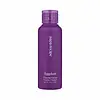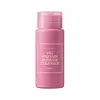What's inside
What's inside
 Key Ingredients
Key Ingredients

 Benefits
Benefits

 Concerns
Concerns

No concerns
 Ingredients Side-by-side
Ingredients Side-by-side

Zea Mays Starch
AbsorbentSodium Cocoyl Isethionate
CleansingSodium Lauroyl Glutamate
Diglycerin
HumectantBetaine
HumectantSodium Cocoyl Glycinate
CleansingJuglans Regia Shell Powder
AbrasiveAllantoin
Skin ConditioningGlucose
HumectantMaltodextrin
AbsorbentPapain
Skin ConditioningCI 77742
Cosmetic ColorantWater
Skin ConditioningButylene Glycol
HumectantPropanediol
SolventDipropylene Glycol
HumectantSolanum Melongena Fruit Extract
Skin Conditioning1,2-Hexanediol
Skin ConditioningGlycerin
HumectantGanoderma Lucidum Extract
Skin ProtectingLentinus Edodes Extract
Skin ConditioningLactobacillus Ferment
Skin ConditioningSparassis Crispa Extract
Emulsion StabilisingTrametes Versicolor Extract
Hyaluronic Acid
HumectantHydrolyzed Hyaluronic Acid
HumectantSodium Hyaluronate
HumectantPrunus Amygdalus Dulcis Fruit Extract
Skin ConditioningTremella Fuciformis Extract
HumectantTabebuia Impetiginosa Bark Extract
Skin ConditioningEthylhexylglycerin
Skin ConditioningZea Mays Starch, Sodium Cocoyl Isethionate, Sodium Lauroyl Glutamate, Diglycerin, Betaine, Sodium Cocoyl Glycinate, Juglans Regia Shell Powder, Allantoin, Glucose, Maltodextrin, Papain, CI 77742, Water, Butylene Glycol, Propanediol, Dipropylene Glycol, Solanum Melongena Fruit Extract, 1,2-Hexanediol, Glycerin, Ganoderma Lucidum Extract, Lentinus Edodes Extract, Lactobacillus Ferment, Sparassis Crispa Extract, Trametes Versicolor Extract, Hyaluronic Acid, Hydrolyzed Hyaluronic Acid, Sodium Hyaluronate, Prunus Amygdalus Dulcis Fruit Extract, Tremella Fuciformis Extract, Tabebuia Impetiginosa Bark Extract, Ethylhexylglycerin
Zea Mays Starch
AbsorbentSodium Cocoyl Isethionate
CleansingSodium Lauroyl Glutamate
Hydrolyzed Hyaluronic Acid
HumectantFicus Carica Fruit Water
MaskingAspergillus Ferment
Skin ConditioningTriticum Aestivum Seed Extract
PerfumingFicus Carica Fruit Extract
HumectantSodium Myristoyl Glutamate
CleansingAllantoin
Skin ConditioningPapain
Skin ConditioningGlycerin
HumectantMandelic Acid
AntimicrobialMaltodextrin
AbsorbentWater
Skin Conditioning1,2-Hexanediol
Skin ConditioningLipase
Skin ConditioningProtease
ExfoliatingFicin
Skin ConditioningParfum
MaskingZea Mays Starch, Sodium Cocoyl Isethionate, Sodium Lauroyl Glutamate, Hydrolyzed Hyaluronic Acid, Ficus Carica Fruit Water, Aspergillus Ferment, Triticum Aestivum Seed Extract, Ficus Carica Fruit Extract, Sodium Myristoyl Glutamate, Allantoin, Papain, Glycerin, Mandelic Acid, Maltodextrin, Water, 1,2-Hexanediol, Lipase, Protease, Ficin, Parfum
 Reviews
Reviews

Ingredients Explained
These ingredients are found in both products.
Ingredients higher up in an ingredient list are typically present in a larger amount.
1,2-Hexanediol is a synthetic liquid and another multi-functional powerhouse.
It is a:
- Humectant, drawing moisture into the skin
- Emollient, helping to soften skin
- Solvent, dispersing and stabilizing formulas
- Preservative booster, enhancing the antimicrobial activity of other preservatives
Allantoin is a soothing ingredient known for its protective and moisturizingg properties. Because of this, it is often added to products with strong active ingredients.
Studies show higher concentrations of this ingredient can promote wound healing.
Though it can be derived from the comfrey plant, allantoin is produced synthetically for cosmetic products to ensure purity.
Learn more about AllantoinGlycerin is already naturally found in your skin. It helps moisturize and protect your skin.
A study from 2016 found glycerin to be more effective as a humectant than AHAs and hyaluronic acid.
As a humectant, it helps the skin stay hydrated by pulling moisture to your skin. The low molecular weight of glycerin allows it to pull moisture into the deeper layers of your skin.
Hydrated skin improves your skin barrier; Your skin barrier helps protect against irritants and bacteria.
Glycerin has also been found to have antimicrobial and antiviral properties. Due to these properties, glycerin is often used in wound and burn treatments.
In cosmetics, glycerin is usually derived from plants such as soybean or palm. However, it can also be sourced from animals, such as tallow or animal fat.
This ingredient is organic, colorless, odorless, and non-toxic.
Glycerin is the name for this ingredient in American English. British English uses Glycerol/Glycerine.
Learn more about GlycerinHydrolyzed Hyaluronic Acid is a form of hyaluronic acid. It is created by the hydrolysis of hyaluronic acid with a high molecular weight. Once created, Hydrolyzed Hyaluronic Acid has a low molecular weight.
Low molecular weight HA has been shown to hydrate and increase elasticity of the skin. Increasing elasticity is also associated with reduction of wrinkle depth.
One study found topical low molecular weight hyaluronic acid may be considered for the treatment of rosacea in the adult population. However, we always recommend speaking with a professional about your skin concerns.
Hyaluronic acids are a humectant. This means they draw moisture from the air. Hyaluronic acids help moisturize, soothe, and protect the skin.
Read more about other common forms of hyaluronic acid:
Learn more about Hydrolyzed Hyaluronic AcidMaltodextrin is a polysaccharide. It is derived from starch such as rice, corn, wheat, or potato starch.
In food, Maltodextrin is used to improve the texture and thicken a product. Due to its structure, it can help create a gel texture. As an emulsion stabilizer, it helps keep the ingredients in a product together.
As a polysaccharide, Maltodextrin has moisturizing properties. Polysaccharides are a type of carbohydrate. The top layer of skin uses polysaccharides to retain water, keeping the skin hydrated.
Maltodextrin is water soluble and has a sweet taste.
Learn more about MaltodextrinPapain is an enzyme found naturally in the papaya plant's leaves, fruit, and roots. It has antimicrobial, soothing, and wound healing properties.
Glycine and Vitamin A are naturally found in papain.
While papain is often touted as skin-lightening, further studies are needed to prove this. However, papain has been shown to help soothe acne-inflammation.
Papain belongs to a class of enzymes called proteolytic enzymes. These enzymes break down peptides and amino acids.
Some studies found papain to be a potential skin sensitizer and allergen. Those with latex allergies might also be allergic to papaya.
Learn more about PapainSodium cocoyl isethionate is a natural ingredient from coconut oil. It is an ultra gentle cleanser that gives a nice foam without drying the skin or impacting the skin barrier.
The amount of foam created depends on the amount of sodium cocoyl isethionate used in the product.
This ingredient also helps improve the spreadability of a product.
Learn more about Sodium Cocoyl IsethionateSodium Lauroyl Glutamate is the sodium salt from the lauric acid of glutamic acid.
It is a surfactant and helps cleanse the skin. Surfactants gather oil, dirt, and other pollutants from your skin so they may be washed away easily.
Water. It's the most common cosmetic ingredient of all. You'll usually see it at the top of ingredient lists, meaning that it makes up the largest part of the product.
So why is it so popular? Water most often acts as a solvent - this means that it helps dissolve other ingredients into the formulation.
You'll also recognize water as that liquid we all need to stay alive. If you see this, drink a glass of water. Stay hydrated!
Learn more about WaterZea Mays Starch is starch made from corn. You might know this as cornstarch . It is used to thicken a product. It can replace talc as an absorbent.
The pH of cornstarch is 5.92.
Cornstarch is a common food ingredient used to thicken soups or to make corn syrup.
Learn more about Zea Mays Starch